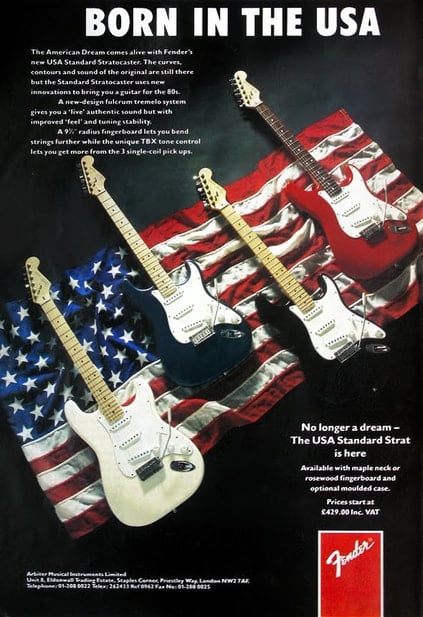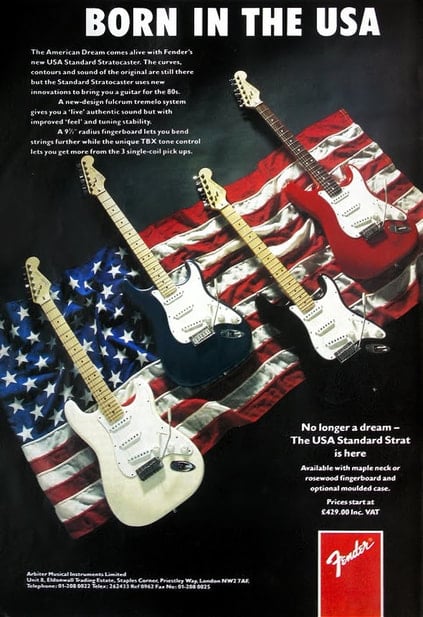FENDER AMERICAN STANDARD STRATOCASTER - FIRST SERIES
|
In 1985, Fender, after the buyout that led to Bill Schultz being its new President, was a totally new company which had to distance itself from CBS in order to survive.
Bill Schultz had always been firmly convinced that a business that did not grow and improve was destined to burn out. In other words, he was persuaded that the Fender icon, the Stratocaster, had to be recovered and adapted to modern times to bring the company back to the glories of the past. Neither a reissue nor a “premium” guitar was necessary; there was no need even to level the costs. It was enough to take Leo's old guitar and partially modify it, (without changing its basic structure), to make it more competitive. He then tried to imagine, together with his collaborators, what Leo Fender himself would have done to modernize the Stratocaster. The new American Standard Stratocaster, so named to reiterate the concept that it was made in USA and not elsewhere, was officially presented at NAMM in January 1987, but began to be developed by Dan Smith and George Blanda as early as 1986. |
A small headstock (with whitish Fender logo), the BiFlex truss rod (designed by Charlie Gressett), the neck fixed to the body by four screws and the micro tilt were main features of the new American Standard Strat. The radius was 9.5" and the fretboard had twenty-two medium jumbo frets - the addition of the 22nd one not changing the position of the pickups on the body.
|
As for the electronics, the TBX tone control system, which had already been used for the Elite and would soon be fitted also on the Strat Plus and Clapton Stratocaster, stood out. TBX allowed a player to cut treble and bass by turning the tone knob, differently from the classic tone pot which cut only treble. However, the increase in the mids derived from the attenuation of the other two frequencies let one suppose that it was an active system, but instead it was passive, as it cut and it did not amplify. Hence the different interpretations of the acronym: Treble Bass eXpander and Treble Bass Cuts (X).
|
But a new bridge was the most important innovation. Indeed, the Synchronized Tremolo, the flagship of Leo Fender’s guitar, had been redesigned during CBS management in order to lower costs and worsened due to the use of a poor die-cast metal; neither Elite Freeflyte Tremolo proved to be a bridge worthy of Stratocaster. The new bridge designed for the American Standard wasn’t manufactured by inserting liquid metal into a mold as it was customary in CBS period, but pouring powdered metal – as Fender called it - in a press in which very high pressures were applied. The tremolo block was angled and manufactured with low carbon steel (obtained through the powdered metal process). The very first tremolo blocks were nickel-coated but, in a short time, they would be painted and, starting from the '90s, powder-coated. However, in the initial project the junction point with the base plate had to be bare and uncoated; it is therefore not clear why the whole block, junction point included, began to be soon powder-coated. Saddles were filled and composed of a single block realized through the powdered metal process and had a small slot to slide the strings; they were therefore not manufactured either through Leo’s bending process or CBS die-cast metal. The base plate was cold-rolled steel that was punched out of a flat sheet. The new bridge was anchored to the Stratocaster by two large side pivots and no longer six screws, and this is why the American Standard Tremolo is often called also 2-Point Synchronized Tremolo. The bridge thus built was simple and economic and, above all, produced a good sound, although it was obtained through an industrial process.
The first American Standard Stratocasters had the two pivot studs going straight into the body; between April 1987 and the early 1988 Fender changed the bridge and the new one had two pivot studs going into threaded inserts.
The first American Standard Stratocasters had the two pivot studs going straight into the body; between April 1987 and the early 1988 Fender changed the bridge and the new one had two pivot studs going into threaded inserts.
His pickups were flat-poles and didn't have a specific name, but later they would be simply called American Standard Pickups. The pickup in the middle was reverse wound/reverse polarity (RWRP), which makes it hum-canceling in the 2 and 4 "in between" positions. Each pickup no longer occupied a single space in the body of the guitar, but they were all inserted in a larger compartment called the swimming pool rout. In 1998, however, the first body with HSH routing appeared and in 1999 it replaced definitively the swimming pool. The wood of the body remained alder; but in the early '90s poplar was utilized too due to some deforestation laws in Oregon, and in the second half of the '90s swamp ash was used for White Blonde and Natural finishes.
The body was almost always covered by three successive layers of polyurethane (undercoat, color coat, clear coat); however Dan Smith declared, for a short period, that a polyester undercoat was preferred to the polyurethane one in order to make the color adhere better, while a polyurethane clear coat and a layer of color, that could have been polyurethane or could be made of the classic lacquers, were preserved.
Since late 1989 ca., it often happened that below the solid colors, but also in some sunbursts, (in which the whole back concavity was black), there was a body composed of a veneer top and back. George Blanda and Dan Smith justified by declaring that it was just an artifice to make solid colors adhere better and prevent mineral buildup from depositing along the grains. In any case, the American Standard was the symbol of the new Stratocaster, finally equipped with a bridge that, although not comparable to that of Leo Fender, was at least worthy of his name.
The body was almost always covered by three successive layers of polyurethane (undercoat, color coat, clear coat); however Dan Smith declared, for a short period, that a polyester undercoat was preferred to the polyurethane one in order to make the color adhere better, while a polyurethane clear coat and a layer of color, that could have been polyurethane or could be made of the classic lacquers, were preserved.
Since late 1989 ca., it often happened that below the solid colors, but also in some sunbursts, (in which the whole back concavity was black), there was a body composed of a veneer top and back. George Blanda and Dan Smith justified by declaring that it was just an artifice to make solid colors adhere better and prevent mineral buildup from depositing along the grains. In any case, the American Standard was the symbol of the new Stratocaster, finally equipped with a bridge that, although not comparable to that of Leo Fender, was at least worthy of his name.
ALUMINUM BODY
Between 1994 and 1995 Fender also produced some American Standard Stratocaster and Strat Plus guitars with an aluminum body, which was ordered from Spruce Hill Guitars of Marthy Schulte. These bodies were used also for other projects, including the Custom Shop Freddie Tavares Aloha and Harley Davidson 90th Anniversary Stratocasters.
Made in limited edition, aluminum body American Standard Strat and Strat Plus models were available in three finishes: Blue Metal Burst, Violet Metal Burst and Stars and Stripes, on whose aluminum body the US flag was drawn.
Unfortunately, Fender didn’t keep track of how many aluminum body strats had been produced; we only know that about 400 models, which should not be confused with the Anniversary Stratocasters, had been fabricated.
Made in limited edition, aluminum body American Standard Strat and Strat Plus models were available in three finishes: Blue Metal Burst, Violet Metal Burst and Stars and Stripes, on whose aluminum body the US flag was drawn.
Unfortunately, Fender didn’t keep track of how many aluminum body strats had been produced; we only know that about 400 models, which should not be confused with the Anniversary Stratocasters, had been fabricated.
A SERIAL NUMBER ISSUE: E4 AND N9
The earliest American Standard Stratocaster made in late 1986 and featured a serial number with “E3” (which is quite rare) or “E4” prefix. Furthermore, the “E4” was used until 1988. Many people believe that these guitars were built in 1983 or 1984, but actually they are only decals left over from the CBS management and applied on the new necks after the change of ownership. Thus, “E5”, “E6” and “E7” were never used.
There is also some possible confusion with American Standard with the serial number N9xxxxx, because “N9” has been used by mistake both on the guitars born in 1989 and 1990, and in those born in 1999. The latter are easily distinguishable from the others as they have the Spaghetti logo and the serial number is at the back of the headstock and not at the front as in the case of the guitars made in the '80s and in the early '90s (Fender shifted the position of the serial number in 1995).
There is also some possible confusion with American Standard with the serial number N9xxxxx, because “N9” has been used by mistake both on the guitars born in 1989 and 1990, and in those born in 1999. The latter are easily distinguishable from the others as they have the Spaghetti logo and the serial number is at the back of the headstock and not at the front as in the case of the guitars made in the '80s and in the early '90s (Fender shifted the position of the serial number in 1995).
AMERICAN STANDARD DELUXE STRATOCASTER
It should be remembered that in 1989 Fender presented also the American Standard Deluxe Stratocaster which joined the Plus Series and the American Standard and remained in production for only one year. Equipped with three Lace Sensors Gold, this guitar is confused by many with the Strat Plus, but it can be distinguished because it lacks the Roller Nut and the Locking Tuners.
Antonio Calvosa
















